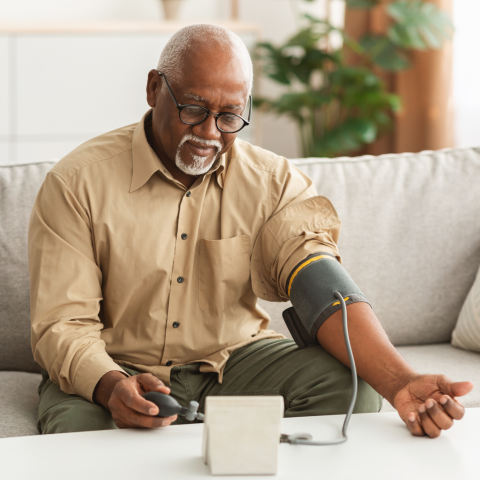
Understanding High Blood Pressure
High blood pressure, also known as hypertension, is a common condition that affects nearly half of all adults in the US. Over time, it can put extra strain on your blood vessels and increase your risk of vascular disease and other serious health conditions if left unmanaged.
By taking steps to understand and manage your blood pressure, you can help protect your vascular health and improve your overall well-being.
Do I Have High Blood Pressure?
Blood pressure is a measure of how much force your blood is exerting against the walls of your arteries as your heart pumps it around your body. When someone from your care team takes your blood pressure, they'll give you two key numbers:
- Systolic (top number): This shows how much pressure your heart needs to push blood through your arteries when it beats.
- Diastolic (bottom number): This measures the pressure in your arteries when your heart is at rest between beats.
Know Your Numbers
| Category | Top Number (Systolic) mm Hg | And/or | Bottom Number (Diastolic) mm Hg |
| Normal | Less than 120 | And | Less than 80 |
| Elevated | 120-129 | And | Less than 80 |
| High Blood Pressure (Stage 1) | 130-139 | Or | 80-89 |
| High Blood Pressure (Stage 2) | 140 or higher | Or | 90 or higher |
| Hypertensive Crisis (Seek Emergency Care) | Higher than 180 | And/Or | Higher than 120 |
Regular blood pressure checks are vital to catching high blood pressure early and managing it effectively.
How Does High Blood Pressure Affect My Vascular Health?
When your blood pressure stays high for too long, it creates excess force against the walls of your arteries. Over time, this pressure can cause them to become stiff, narrow, and weakened, making it harder for blood to flow properly.
This damage can lead to a number of problems, including:
- Narrowing of the Arteries: High blood pressure speeds up plaque buildup in the arteries, a condition known as atherosclerosis. This narrows the arteries and reduces blood flow, increasing the risk of heart attack, stroke, Peripheral Artery Disease (PAD), and Carotid Artery Disease (CAD).
- Aneurysms: The constant strain from high blood pressure can weaken the blood vessel walls, leading to aneurysms, especially in the aorta. If an aneurysm bursts, it can cause severe internal bleeding and be fatal without immediate treatment.
- Dissections: High blood pressure can also cause a tear in the artery walls, called a dissection. Aortic dissection is a life-threatening emergency, and arterial dissections can lead to stroke or organ damage if not treated immediately.
- Damage to Organs: High blood pressure puts long-term strain on vital organs like the heart, kidneys, and eyes. Over time, it can lead to heart failure, kidney disease, and damage to the blood vessels in the eyes, potentially causing vision problems or blindness.
Different Types of High Blood Pressure
There are two main types of high blood pressure: primary hypertension and secondary hypertension. While both types involve elevated blood pressure, they differ in their causes and how they develop. Understanding these differences can help identify the most effective treatment strategies for managing your condition.
- Primary Hypertension: has no single identifiable cause, but it is influenced by a combination of genetic factors, lifestyle choices (such as diet, exercise, and stress), and environmental factors. It develops gradually over time and accounts for most hypertension cases.
- Secondary Hypertension: is caused by an underlying medical condition or medication, such as kidney disease, hormonal disorders, or obstructive sleep apnea. It may develop suddenly or worsen rapidly in response to the triggering condition.
Understanding the type of high blood pressure you have is key to determining the right treatment and management approach.
Treatment Options
Lifestyle Changes
Managing high blood pressure starts with making lifestyle changes. Here are some effective steps you can take:
- Follow a heart-healthy diet: Focus on fruits, vegetables, whole grains, and lean proteins. Limit salt, added sugars, and saturated fats. Try incorporating potassium-rich foods, such as bananas, spinach, and sweet potatoes, to help balance sodium levels.
- Stay active: Aim for at least 30 minutes of moderate-intensity exercise, like walking or cycling, on most days. Physical activity strengthens your heart and helps lower blood pressure.
- Manage stress effectively: Practice relaxation techniques like meditation, deep breathing, or yoga to reduce daily stress. Chronic stress can contribute to elevated blood pressure over time.
- Avoid smoking and limit alcohol: Smoking damages your blood vessels, while excessive alcohol can raise blood pressure. Quitting smoking and drinking in moderation can have immediate benefits.
- Monitor your blood pressure: Use a home blood pressure monitor to keep track of your numbers. Share your readings with your doctor to stay on top of your progress.
Small, consistent changes can make a big difference in maintaining healthy blood pressure levels and protecting your vascular health.
Medications
Sometimes, lifestyle changes alone aren’t enough to lower your blood pressure, so your healthcare provider may prescribe medication to help.
Common medications include:
- Diuretics: Help your body eliminate excess sodium and water, reducing the amount of fluid in your blood vessels.
- Angiotensin-Converting Enzyme (ACE) Inhibitors and Angiotensin II Receptor Blockers (ARBs): Relax and widen blood vessels, making it easier for blood to flow.
- Calcium Channel Blockers: Lower blood pressure by relaxing blood vessel walls and reducing the heart’s workload.
- Beta Blockers: Reduce blood pressure by slowing the heart rate and decreasing the force of heart contractions, helping the heart work more efficiently.
To manage your blood pressure effectively, it’s important to combine healthy lifestyle changes with the appropriate treatment plan tailored to you. Work closely with your care team to determine the best approach and schedule regular follow-ups to ensure your blood pressure stays within a safe range and reduce the risk of complications.
